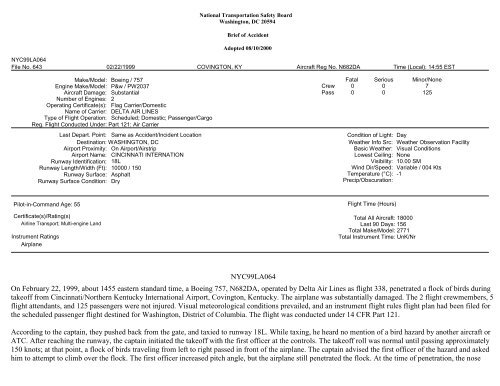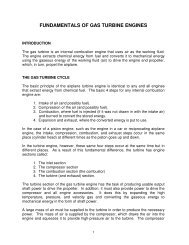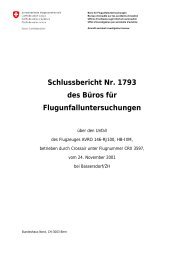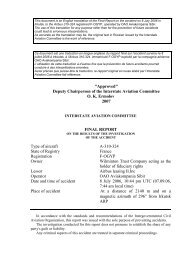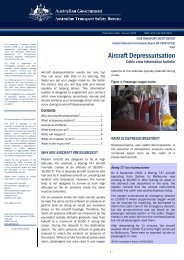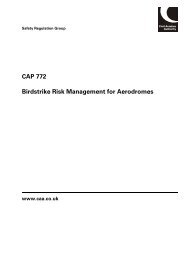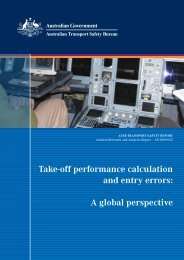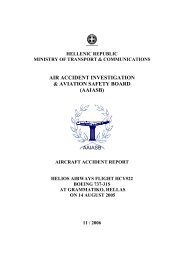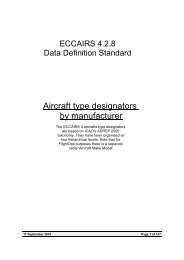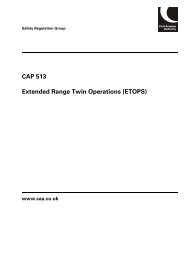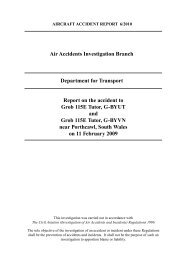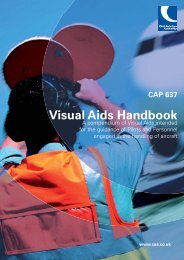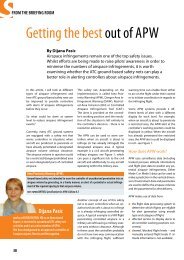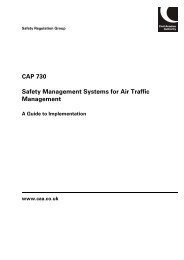View this book - SKYbrary
View this book - SKYbrary
View this book - SKYbrary
You also want an ePaper? Increase the reach of your titles
YUMPU automatically turns print PDFs into web optimized ePapers that Google loves.
NYC99LA064<br />
File No. 643 02/22/1999<br />
Make/Model: Boeing / 757<br />
Engine Make/Model: P&w / PW2037<br />
Aircraft Damage: Substantial<br />
Number of Engines: 2<br />
Operating Certificate(s): Flag Carrier/Domestic<br />
Name of Carrier: DELTA AIR LINES<br />
Type of Flight Operation: Scheduled; Domestic; Passenger/Cargo<br />
Reg. Flight Conducted Under: Part 121: Air Carrier<br />
Last Depart. Point: Same as Accident/Incident Location<br />
Destination: WASHINGTON, DC<br />
Airport Proximity: On Airport/Airstrip<br />
Airport Name: CINCINNATI INTERNATION<br />
National Transportation Safety Board<br />
Washington, DC 20594<br />
Brief of Accident<br />
Adopted 08/10/2000<br />
COVINGTON, KY Aircraft Reg No. N682DA<br />
Fatal<br />
Crew 0<br />
Pass 0<br />
Time (Local): 14:55 EST<br />
Serious Minor/None<br />
0 7<br />
0 125<br />
Condition of Light: Day<br />
Weather Info Src: Weather Observation Facility<br />
Basic Weather: Visual Conditions<br />
Lowest Ceiling: None<br />
Runway Identification: 18L Visibility: 10.00 SM<br />
Runway Length/Width (Ft): 10000 / 150<br />
Runway Surface: Asphalt<br />
Runway Surface Condition: Dry<br />
Pilot-in-Command Age: 55<br />
Certificate(s)/Rating(s)<br />
Airline Transport; Multi-engine Land<br />
Instrument Ratings<br />
Airplane<br />
Wind Dir/Speed: Variable / 004 Kts<br />
Temperature (°C): -1<br />
Precip/Obscuration:<br />
Flight Time (Hours)<br />
Total All Aircraft: 18000<br />
Last 90 Days: 156<br />
Total Make/Model: 2771<br />
Total Instrument Time: UnK/Nr<br />
NYC99LA064<br />
On February 22, 1999, about 1455 eastern standard time, a Boeing 757, N682DA, operated by Delta Air Lines as flight 338, penetrated a flock of birds during<br />
takeoff from Cincinnati/Northern Kentucky International Airport, Covington, Kentucky. The airplane was substantially damaged. The 2 flight crewmembers, 5<br />
flight attendants, and 125 passengers were not injured. Visual meteorological conditions prevailed, and an instrument flight rules flight plan had been filed for<br />
the scheduled passenger flight destined for Washington, District of Columbia. The flight was conducted under 14 CFR Part 121.<br />
According to the captain, they pushed back from the gate, and taxied to runway 18L. While taxing, he heard no mention of a bird hazard by another aircraft or<br />
ATC. After reaching the runway, the captain initiated the takeoff with the first officer at the controls. The takeoff roll was normal until passing approximately<br />
150 knots; at that point, a flock of birds traveling from left to right passed in front of the airplane. The captain advised the first officer of the hazard and asked<br />
him to attempt to climb over the flock. The first officer increased pitch angle, but the airplane still penetrated the flock. At the time of penetration, the nose
wheel was in the air and the main landing gear was just becoming airborne. The captain advised ATC of the event, and was cleared to land.<br />
After advising ATC, the flight crew performed left traffic for runway 18L, landed, and taxied to the gate without further incident. The captained observed no<br />
change in engine performance or flight characteristics during or after the event. He added that the birds were small and brown, with white spots.<br />
A review of the flight data record revealed that approximately 1 second after the airplane's main landing gear transitioned from ground to flight, the N1 on the<br />
left engine dropped from 81.88 percent to 56.00 percent, and the right engine dropped from 81.25 to 71.63 percent. In both cases, throttle positions remained<br />
constant. In addition, pitch was 19.16 degrees nose up, and airspeed was 152.5 knots at the time of the event.<br />
Examination of both engines by the operator, revealed damage to the first stage of the compressor sections on the number 1, and number 2 engines. The section<br />
were changed, and the aircraft was returned to service.<br />
On February 23 and 24, 1999, a Federal Aviation Administration Wildlife Biologist examined the airport operations area (AOA). In his report, he wrote, "The<br />
starlings [Sturnus vulgaris] involved in the strike appear to have been a random foraging flock. Careful inspection of the area where the starlings were just prior<br />
to the strike did not reveal any anomalies or anything remarkably different from virtually every other grassed area within the AOA."<br />
He continued, "It is difficult to say with any degree of certainty whether or not the starlings involved in the strike had been roosting in the terminal area trees.<br />
In that part of the country, starlings will form large winter roost wherever they can find suitable habitat conditions. Some winter roost can contain several<br />
million birds. Winter roosting starlings will fly up to 50 miles (one-way) daily to feed. The starlings involved in the strike could have come from the terminal<br />
roost area or they could have come from a roost many miles from the airport."<br />
The FAA publication titled Hazardous Wildlife Attractants On Or Near Airports, states that "All species of wildlife can pose a threat to aircraft safety." In<br />
addition, it stated that starlings comprised 5 percent of all damaging animal strikes to U.S. aircraft from 1993 to 1995.<br />
The National Transportation Safety Board determines the probable cause(s) of <strong>this</strong> accident as follows.<br />
A flock birds were ingested into both engines, resulting in substantial damage to the engines.


